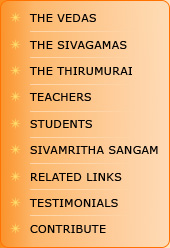
 |
|||
 |
SIVAGAMA-S Saivagamas, the specific scriptures of Saivism, are divided into Moolagama-s and Upagama-s. The Moolagama-s are the main agamas, and the Upagama-s are the subsidiary ones. The first group are 28 in number and the latter are 207. The following are the twenty-eight moolagama-s:
Each Agama consists of four parts, known as padas. They are
It deals with the systematic means for the individual and for social harmony.. It also covers various dimensions of Dharma, the discipline to be followed by every human being, and the materials of Siva pooja. Kriya padaIt focuses upon all the details regarding the temple, which includes where the temple is to be built, the forms of deities, and the procedure for their installation Further, details of daily poojas, Utsavas or festivals, Prayaschitas or expiatory rites are also mentioned here. The details and the explanation of Deeksha, the main samskara or sacrament which makes a person realize the nature of Siva in himself, are also described in this portion. Yoga PadaThe Yoga pada deals with Ashtanga Yoga (the Eight Limbed Path), a step by step progress towards the goal. The eight parts are Yama, Niyama, Asana, Pranayama, Prathyahara, Dhrana, Dhyana and Samadhi. The first four steps known as “Bahya Sadhana” deal with the external techniques which regulate the physic and the sense organs; the latter four steps deal with the internal techniques which enable one to develop a highly focused, disciplined and contented mind. Gnana PadaPathi—Siva, Pasu—souls, and Pasam—Bondage are the trinity explained in this part of Agama. The beauty lies in the systematic means in Gnana Pada which enables one to realize in a reasoned and convincing manner.the ultimate truth which is beyond the limited human intellect. Apart from this the Saivagamas also give elaborate details on ontology, cosmology, devotion, the philosophy of mantras, Jyothisam, mystic diagrams, charms and spells, domestic observances, classical music, temple arts, etc. All knowledge is in the Saivagamas- -- Acharya Nigamagnanadesika The study and Practice of Saivagama will definitely bring peace to the world. |
||||||||||||||||||||||||||||||||||||||||||||||||||||||||||||||
Copyright © 2018 Sri Skandaguru Vidyalayam.
|
|||||||||||||||||||||||||||||||||||||||||||||||||||||||||||||||